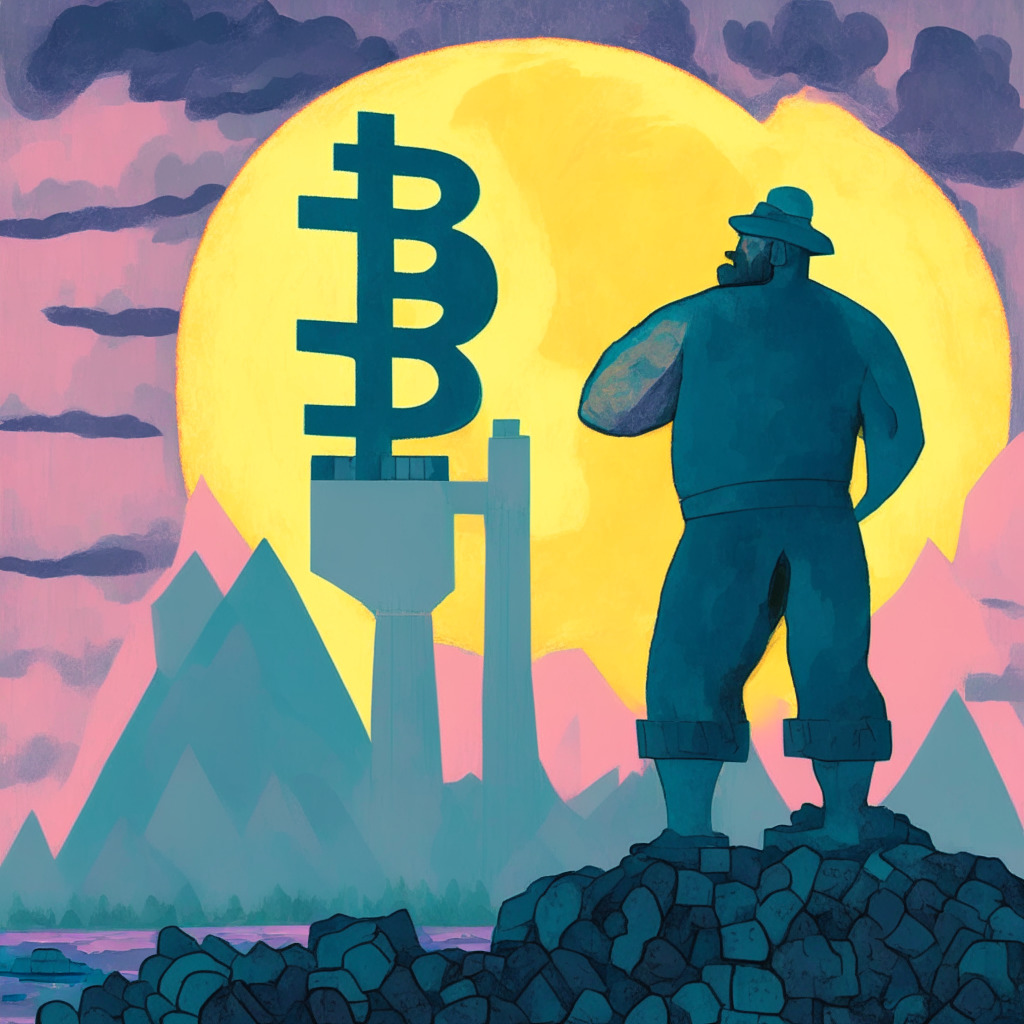“Expectations grow as Federal Reserve Chairman, Jerome Powell’s comments historically impact financial markets including cryptocurrencies. Amid this anticipation, recommended choices are Render, Sonik Coin, Immutable X, yPredict, and Internet Computer, notable for their robust fundamentals and encouraging technical analysis.”
Search Results for: Reserve
Bitcoin’s Value: Fed Chair Influence and Miner Confidence Amidst Market Speculation
Amid varied opinions, Fairlead Strategies’s Katie Stockton suggests a possible return of Bitcoin’s price to the $20,000 range if it goes below a crucial support level of $25,200. The Jackson Hole Symposium, led by Federal Reserve Chair Jerome Powell, could introduce volatility in crypto markets, while miners’ confidence adds stability. Future Bitcoin value could be impacted by rate hikes or unchanged rates.
Unpredictability and Opportunity: The Highs and Lows of the Evolving Crypto Market
Amidst prevailing market concerns, unpredictable and illiquid market of ‘shitcoin’ and meme coins are defying broader sentiment with major gains. The crypto market remains a high-risk asset class, evolving with dynamic opportunities and new market players with potential for remarkable gains.
Crypto Correction and Market Downfalls: The Bittersweet Symphony of Financial Growth
The cryptocurrency market, including Bitcoin and Ether, is in a ‘significant downtrend,’ following last week’s sudden drop. This mirrors a downwards trend in traditional markets such as the Nasdaq Composite and S&P 500. Despite this, the economy continues absorbing policies from the past 16 months without visible harm to spending or job creation.
Navigating Bitcoin’s Unsteady Path: Influence of SEC Regulations and Fear of Inflation
In this article, we explore the recent 10% drop in Bitcoin value, critiqued regulatory methods of the US’s Securities and Exchange Commission and its influence on Bitcoin’s price fluctuation. A looming economic disaster by Federal Reserve policy mishaps is also cautioned, potentially influencing the future trajectory of Bitcoin.
XRP20 vs XRP: Robinhood’s Next Big Crypto and What It Means for Traders
“Rumors suggest XRP may join Robinhood’s crypto lineup, which could benefit XRP20, a token resembling XRP but with distinct features. XRP20 is an attractive investment due to token burning and mass adoption. With a clear smart contract and high community trust, it’s considered safe and reliable. XRP20 also promises passive income through community rewards and showcases potential for capital gain.”
Cryptocurrency Upsurge Amid US Economic Concerns: A Risky Haven or Volatile Minefield?
“In the midst of weaker US survey data, leading cryptocurrency prices have been appreciating. Surprisingly, the fear of further interest rate hike has been placated, leading to positive cryptocurrency performance. Meanwhile, volatile meme coin markets present quick gain opportunities. However, cryptocurrency trading remains a high-risk pursuit, requiring thorough due diligence and careful investment.”
Longest Negative Year for Bitcoin: A Dark Tunnel with Light at its End?
Despite Bitcoin’s recent longest negative year-over-year returns, Dan Morehead, founder of crypto investment firm Pantera Capital, remains optimistic. He believes the half-cut of the BTC block reward for mining in April 2024 will propel bitcoin’s price. His models suggest that bitcoin will reach around $35,500 by the halving and nearly $150,000 by late 2025. Amid market fluctuations, Bitcoin’s future trajectory continues to raise questions.
Unveiling the eAUD: The Future of Australia’s Digital Currency and Its Challenges
The Reserve Bank of Australia’s (RBA) central bank digital currency (CBDC) project results suggest a potential to enhance efficiency and resilience in the payment system. However, obstacles such as “legal, regulatory, technical and operational considerations” might delay the actual implementation of CBDC in Australia.
Analyzing Bitcoin Market Fluctuations: Impacts, Future Prospects, and Resiliency Amid Recession
“In his analysis, Mike Colonnese discusses recent Bitcoin (BTC) market fluctuations, attributing the sharp drop to SpaceX’s decision to devalue its BTC holdings and concerns sparked by Evergrande’s bankruptcy. He also outlines potential future trends, including possible boost in BTC prices if the Federal Reserve cuts rates amidst a recession, and impact of upcoming halving event in 2024.”
Australia’s Tentative Steps Towards Central Bank Digital Currency: Hopes and Hurdles
The Reserve Bank of Australia (RBA) and the Digital Finance Cooperative Research Centre’s study determined that the introduction of a Central Bank Digital Currency (CBDC) may not occur for several years in Australia due to numerous unresolved issues. The research viewed CBDC as a complementary tool to private sector innovation rather than a replacement, supporting offline electronic payments, facilitating transactions, and reducing costs.
Navigating the CBDC’s Challenges and Potential: A Glimpse into Australia’s e-AUD Experiment
The Reserve Bank of Australia’s pilot program for a Central Bank Digital Currency (CBDC) has explored potential benefits and challenges of tokenized currencies such as an e-AUD. The program highlighted opportunities for financial innovation and resilience in the digital economy, but also demonstrated legal ambiguities and uncertainties surrounding CBDC use.
Bitcoin’s Slump Below $26,000: Macroeconomic Factors and The Uncertain Future of Cryptocurrencies
Bitcoin’s recent slump mirrors an overall downturn in the crypto market, influenced by stricter monetary policies aimed at curbing inflation. Despite these challenging conditions and financial uncertainty, the potential introduction of US Bitcoin and Ether futures exchange-traded funds could provide a robust catalyst for the industry.
Navigating High-Risk, High-Reward Opportunities on Crypto Frontier: A Look beyond Bitcoin and Ether
“Amidst mainstream cryptocurrency market challenges, investors with high-risk tolerance explore fringe cryptos which can yield astronomical intra-day gains. However, these assets carry certain risks like buy and sell taxes, large volume transaction prevention, and trading cool-down mechanisms. Inherent crypto investment risks underscore the need for due diligence before participation.”
FTX Founder’s High-Stakes Trial: Decoding the Intricacies in Cryptocurrency Lawsuit Precedents
FTX founder Sam Bankman-Fried (SBF) is facing legal difficulties involving fraud and improper use of customers’ funds, which allegedly included billions of dollars from FTX users to offset losses at his hedge fund and make extensive political contributions. This case could potentially set a precedent for future high-profile crypto scams.
Blockchain vs Traditional Payments: A Detailed Analysis of Utility, Constraints and Potential
Cross-border payments demonstrate the utility of digital currencies, yet adoption faces challenges like technological issues, competition, and regulatory constraints. Blockchain Officer, Paul Brody, suggests basic fiat payments are faster and cheaper through centralized systems, while blockchain payments can impact speed and cost due to duplication across nodes. Blockchain’s potential may not lie in replacing existing models, but in altering the transaction rules through tokenization and inherent programmability.
Coinbase Acquires Stake in Circle: Betting Big on Stablecoins and Shaping Cryptocurrency Markets
Coinbase has acquired a minority stake in Circle Internet Financial and both companies dissolved their Centre Consortium associated with issuing USD Coin (USDC). Amid greater regulatory clarity, Circle will become the sole issuer of USDC and control reserve governance, facilitating its integration on various blockchains. This shifting control indicates wider stablecoin adoption in the crypto economy.
Oman’s Inaugural Crypto Mining Facility: Economic Leap or Environmental Misstep?
Oman unveils its second crypto mining center, signaling a substantial step towards bolstering economic digitalization and diversifying away from oil-based revenue sources. However, the environmental impact of large-scale mining and the necessity of striking a balance with sustainability are concerns.
Banking on the Digital Ruble: Heralding a New Era or Stoking Controversy?
The Russian Central Bank’s proposal classifies the digital ruble, as a “high-quality liquid asset”. This could usher a dramatic reconfiguration of how financial institutions perceive and maintain liquid assets, potentially revolutionizing cross-border payment methods. However, this shift is viewed with apprehension among commercial banks.
Future of Gold-Backed BRICS Currency: A Dream or Reality? Debating Pros, Cons, and Bitcoin Effect
“Macroeconomist Lyn Alden argues against the feasibility of a forthcoming gold-backed BRICS currency, citing it a tough challenge for BRICS members. Doubts are raised about the model backing a fractional-reserve banking system with gold.”
Surge in Stablecoin Use Amid Argentina’s Political Turmoil: A Deep Dive into Crypto’s Role in National Economy
Amidst Argentina’s economic crisis and hyperinflation, Argentinians are significantly increasing their purchase of stablecoins as a viable way to protect their savings. The trend, spurred by government restrictions on foreign currency buying and a depreciating peso, also sees an increasing number of transactions and salaries being paid in cryptocurrencies. The upsurge coincides with the rise of presidential candidate, Javier Milei, who holds a positive stance towards cryptocurrencies.
Coinbase Set to Acquire Minority Stake in Circle amidst USD Coin Developments
Coinbase is reportedly purchasing a minority stake in Circle Internet Financial, which coincides with Circle bringing the issuance of the USD Coin entirely in-house. Additionally, six more blockchains are to be integrated with USDC. This move comes amidst increasing competition and regulations within the stablecoin environment.
Blockchain Battleground: How High Interest Rates Impact Bitcoin Value and the Investor’s Dilemma
The recent plunge in Bitcoin’s value is linked to strengthening economic metrics which could lead to extended high interest rates. The speculation around higher neutral interest rates and potential inflation rate increases spooked the cryptocurrency markets, resulting in a drop in Bitcoin’s value.
Bull vs. Bear: An Unending Tussle in the Cryptocurrency Market
The crypto market is caught amidst bullish and bearish forces with Bitcoin, Ethereum, and BNB showing stability despite declining percentages. Data indicates potential buying opportunities, yet advises patience until market correction ends. Interestingly, long-term stake-holders remain unfazed while the crypto community anticipates U.S. Federal Reserve updates for market impact.
XRP20 Listing on Uniswap: Promises, Predictions and Precautions in the Crypto Landscape
“The crypto community anticipates the listing of XRP20 on Uniswap, with over 20 billion tokens already staked, promising yields of approximately 49% annually. This token mirrors XRP’s supply, but operates on the Ethereum blockchain and includes built-in staking features that may mitigate potential sell-off pressures.”
Emergence of Tech Adaptability: Digital Asset Miners Venturing into AI Services
“Digital asset miners are venturing into artificial intelligence, aiming to boost earnings and decrease dependency on conventional cryptocurrency operations. Notably, Bitcoin and Ethereum miners are driving this switch, while some miners continue mining other Proof-of-Work assets. Mining companies are rebranding to echo this trend, finding high-performance computing services for AI firms potentially more profitable than Bitcoin mining.”
Kenya Investigates Worldcoin: Blockchain Technology’s Regulatory Challenges Unveiled
“The Kenyan government has assembled a committee to carry out an investigation into the Worldcoin crypto project, raising concerns over its security implications. Simultaneously, courts have postponed Worldcoin’s activities following a lawsuit filed by the office of the data commissioner. Governments worldwide are becoming increasingly vigilant about potential risks associated with cryptocurrency projects, reflecting the growing mainstream acceptance of blockchain technology.”
Navigating the High Seas of Crypto: Hedera Hashgraph’s Struggles and Sonik Coin’s Ascendance
“Hedera Hashgraph sees mixed market performance amidst growing skepticism despite significant partnerships. Sonik Coin, a promising newcomer, offers a viable route for passive income with its remarkable 4,300% staking APY, seeking stability amidst the turbulent crypto-sea, reminiscent of successful $PEPE, Pepecoin’s trajectory.”
Upcoming Jackson Hole Symposium: A Turning Point for Bitcoin’s Market Turmoil?
“The markets face potential volatility amidst concerns of Bitcoin’s latest price changes, affected by rising unrealized losses and external factors such as statements at the Jackson Hole Economic Symposium. Despite investor fear and the recent 11% BTC drop, historical patterns suggest potential for robust recovery.”
Navigating Through the Storm: China’s Deflation and Impact on Bitcoin’s Future
China’s economic downturn has sparked concerns over potential negative impacts on Bitcoin and other growth-dependent assets. With the onset of deflation, falling prices could amplify debt burdens, stifling spending and investments. These economic shifts underline the need for stakeholders, particularly those invested in Bitcoin, to move forward carefully.
Navigating Uncharted Territory: A Comparative Analysis of Stablecoin Regulation Worldwide
“Recent news around CoinDesk and the temporary pause of their ‘Money Reimagined’ newsletter highlight the challenges faced by crypto media platforms. In this backdrop, a closer look at the regulatory landscapes shows varying global response to cryptocurrencies, notably stablecoins.”
Navigating the Crypto Market Volatility: High Risks and Potential Rewards Amid BTC Sell-Off Pressure
While Bitcoin prices hover at two-month lows, there are fears of a double sell-off before any trend reversals. Market behaviors are divergent, with predictions of increased sell-off or successful price recovery. The upcoming address by the Federal Reserve Chairman triggers heightened anticipation amid this volatility.































